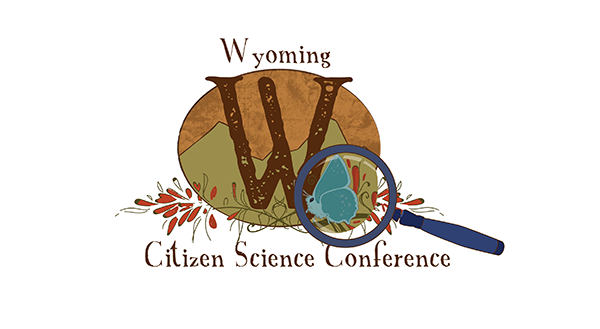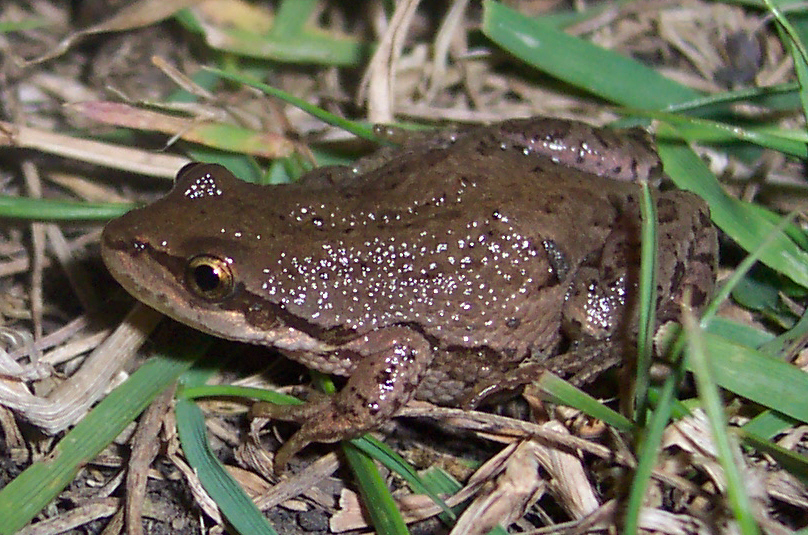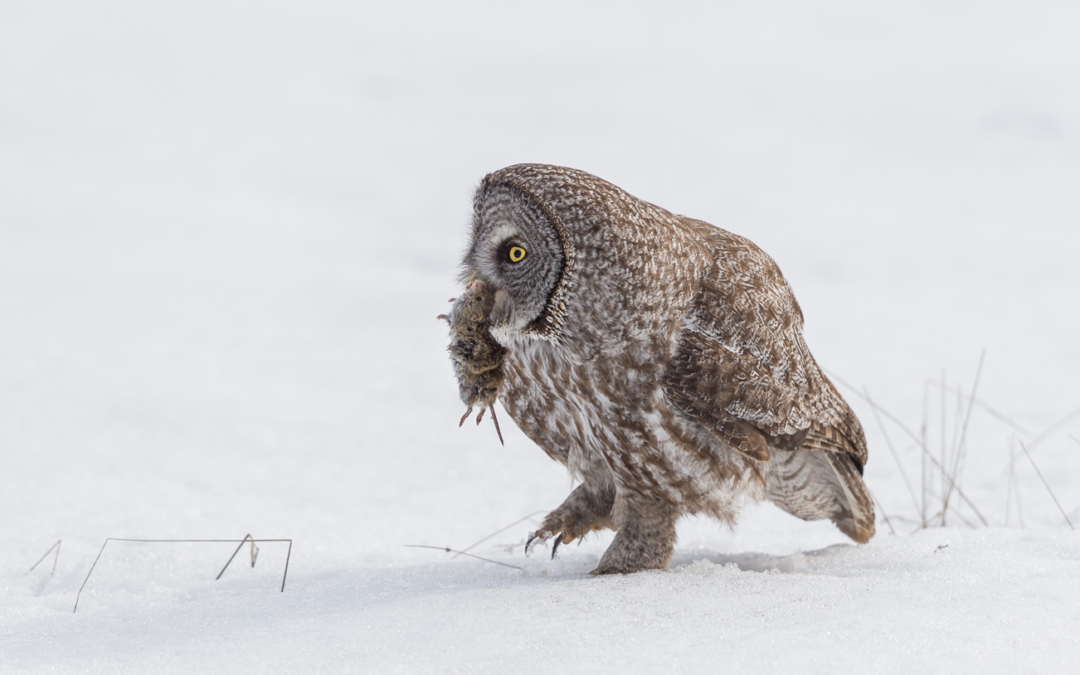
by jhwildlife | Jan 25, 2017 | Blog, Nature Mapping Jackson Hole
by Frances Clark
Wildlife deals with winter in many ways: some leave the valley, many others stay year-round. They may go underground for the duration; adapt their hunting strategies to deep snow–burrowing below or plunging deep; or just keep on moving until they get lucky. Several members of our Nature Mapping community describe how their favorite animals cope:
Amphibians – Debra Patla, Researcher
The four native amphibian species of Jackson Hole have three strategies to get through our harsh winters.
- Western Toads and Tiger Salamanders go underground, under the frost zone where they are safe from freezing.
- Columbia Spotted Frogs survive in water that does not freeze up, such as in underground springs, spring-fed streams and ponds.
- Boreal Chorus Frogs perform a winter miracle – staying near the ground surface under leaves or in small crevices, their bodies freeze in the coldest times and thaw as it warms up. It is a complicated physiological response to winter, shared by only four other amphibian species in North America.
Rarely, chorus frogs make a surprise appearance in winter, in a basement or garage. This has happened in Teton County! Kind rescuers have discovered that you can help them survive until spring by providing a box with moist, clean vegetation in a cool, dark place.
Beaver: Kari Cieszkiewicz, Winter Naturalist, National Elk Refuge
Beavers are highly industrious rodents that depend on meticulous winter preparation for survival. Before the first significant snowfall, beavers have already winterized their lodges and cached enough food, such as aspen, willow and cottonwood cuttings, for months. Since their teeth continuously grow, beaver must chew regularly on bark to maintain their teeth! These highly productive animals spend the summer months obsessively monitoring their ponds, ensuring that their dams are supporting enough water so ponds do not freeze to the bottom or prohibit access to their lodges.
Short-tailed Weasels (Ermine) – Kari Cieszkiewicz, Winter Naturalist, National Elk Refuge
Short-tailed weasels are highly adapted, masterful carnivores that have a surprisingly commanding presence in winter. Their elongated, slender bodies facilitate easy movement through tunnels in the snow, leading them to unsuspecting mice and voles. When the prey is bountiful, weasels will often store their leftover prey in caches beneath the snow for later feasting! During the winter months their fur changes color from tawny-brown to white, allowing them to be camouflage as they discreetly move across the snow.
Boreal Owl – Susan Marsh – Writer, Naturalist
Among our forest winter residents is a small predator, the Boreal Owl. Their coloration allows them to blend in well when perched in a tree so they are easily missed, but in the spruce-fir forests of winter, they are likely around. They hunt small mammals by ambush, from red-backed tree voles to squirrels. The photo, taken by Jim Hawley in lower Cache Creek, shows a Boreal Owl having just caught a red squirrel.
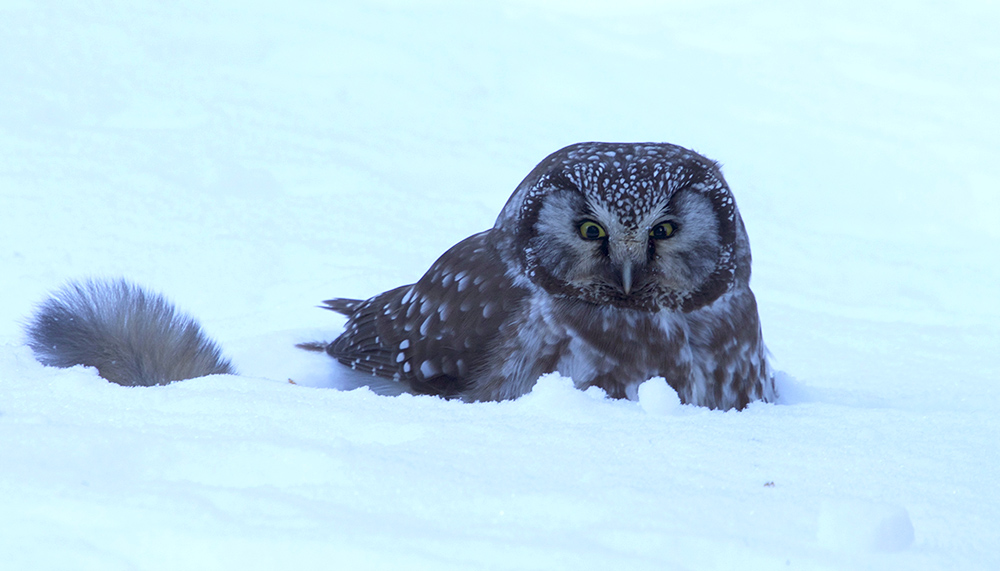
Boreal Owl Photo credit: Jim Hawly
Interesting adaptations that are especially helpful in winter include the asymmetry of the owl’s ears, found in other owl species as well. One opening is higher on the skull and the other much lower. The positions help the owl tell where a sound is coming from. I tried cocking my head in mimic but was woefully inept at finding a flock of chickadees without my eyes. The owl, on the other hand, can locate prey even under the snow.
Great Gray Owl – Katherine Gura, Field Biologist, Teton Raptor Center
A boreal forest raptor species that is circumpolar, found in the northern reaches of North America, Europe and Asia, Great Gray Owls are well-suited to brave the long, harsh winters in Jackson Hole. Locally, Great Gray Owls generally migrate down in elevation in wintertime and are often seen grouped up in the Snake River bottom where presumably there is less snow and more prey available. Equipped with exceptional hearing abilities, Great Gray Owls hunt primarily by sound and penetrate through as much as two feet of snow to capture rodents that are not visible.
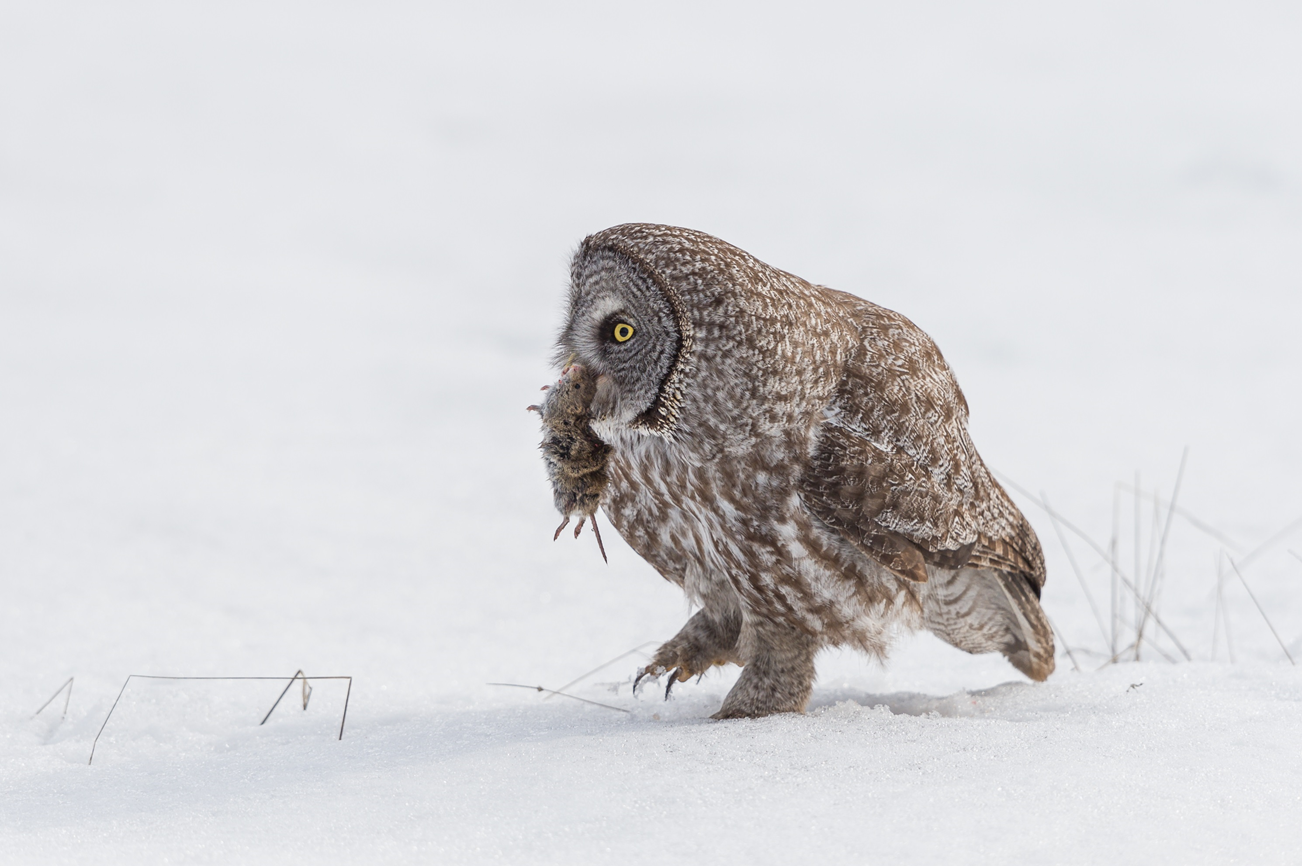
Great Grey Owl Photo Credit: Steve Mattheis
Rough-legged Hawk – Katherine Gura, Field Biologist, Teton Raptor Center
While many species (and people) in Jackson Hole are “snowbirds,” spending summers here and wintering farther south in warmer climes, the Rough-legged Hawk is an exception. In summer months, Rough-legged Hawks breed in the arctic tundra, then migrate south to spend the winter in more “mild” areas in southern Canada and the northern United States. This past year, a Rough-legged Hawk outfitted with a transmitter in northwestern Wyoming migrated north through Alberta and the Northwest territories and finally summered in Nunavut before returning south this fall through Manitoba, Saskatchewan and Alberta. In the wintertime, look for these hawks perched on fence lines and power poles in open areas in the Valley.
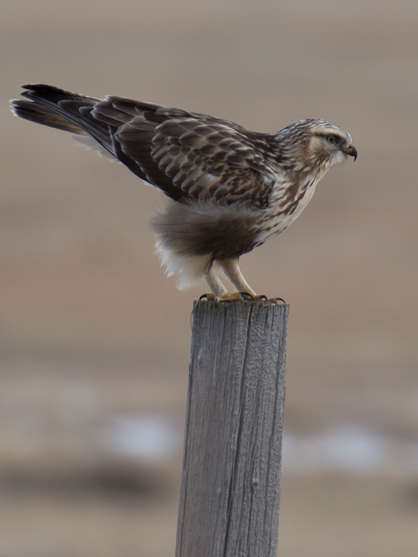
Rough-legged Hawk Photo Credit: Steve Poole
Coyote: Kari Cieszkiewicz, Winter Naturalist National Elk Refuge
As the sun begins to cast its warming light on the snow-covered meadow, a coyote can be seen making very thoughtful, directed movements. Beneath the snow there is a secret society of critters that live in the subnivean (under snow) zone and the coyote can sense their presence. Using its powerful nose, the coyote sniffs at the ground and precisely locates its prey. With one powerful and swift dive-bomb into the snow head-first, the coyote emerges with its breakfast. Based on what prey is available, coyotes are highly adaptable, adjusting their hunting techniques based on their food source.
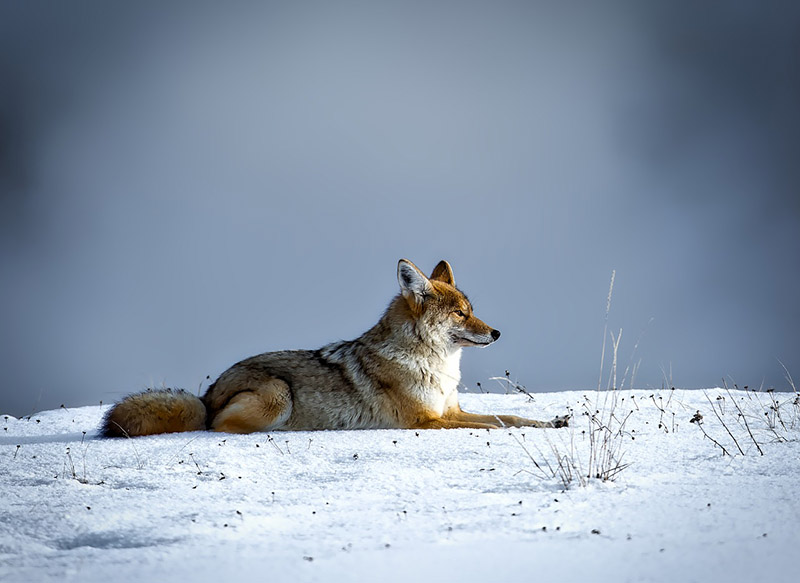
With its long legs and large body, moose are adapted to deep snow and long winters. When deep snow is present, moose are surprisingly sedentary, tending to range over very small areas, browsing on shrubs. Surprisingly, moose may move to high elevation conifer forests during the winter, foraging on lichens that hang from conifer boughs. The large body size of moose affords them a favorable surface-to-volume ratio that increases their heat retention, a distinct advantage over smaller ungulates such as deer.
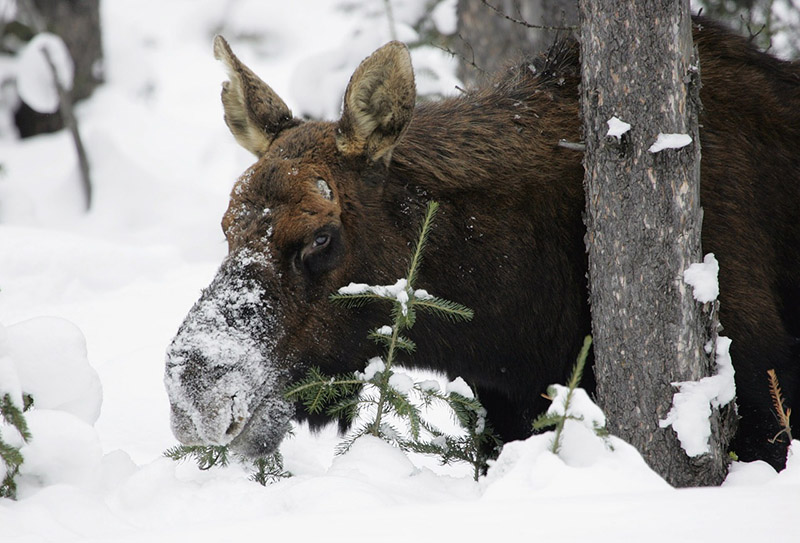
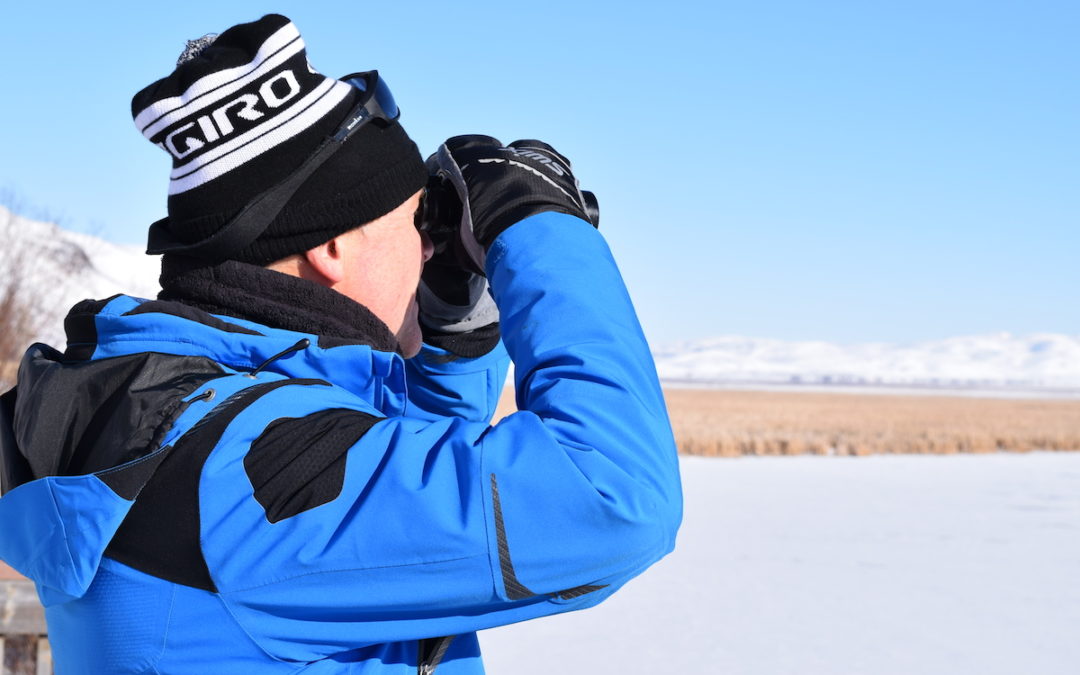
by jhwildlife | Dec 21, 2016 | Blog, Nature Mapping Jackson Hole
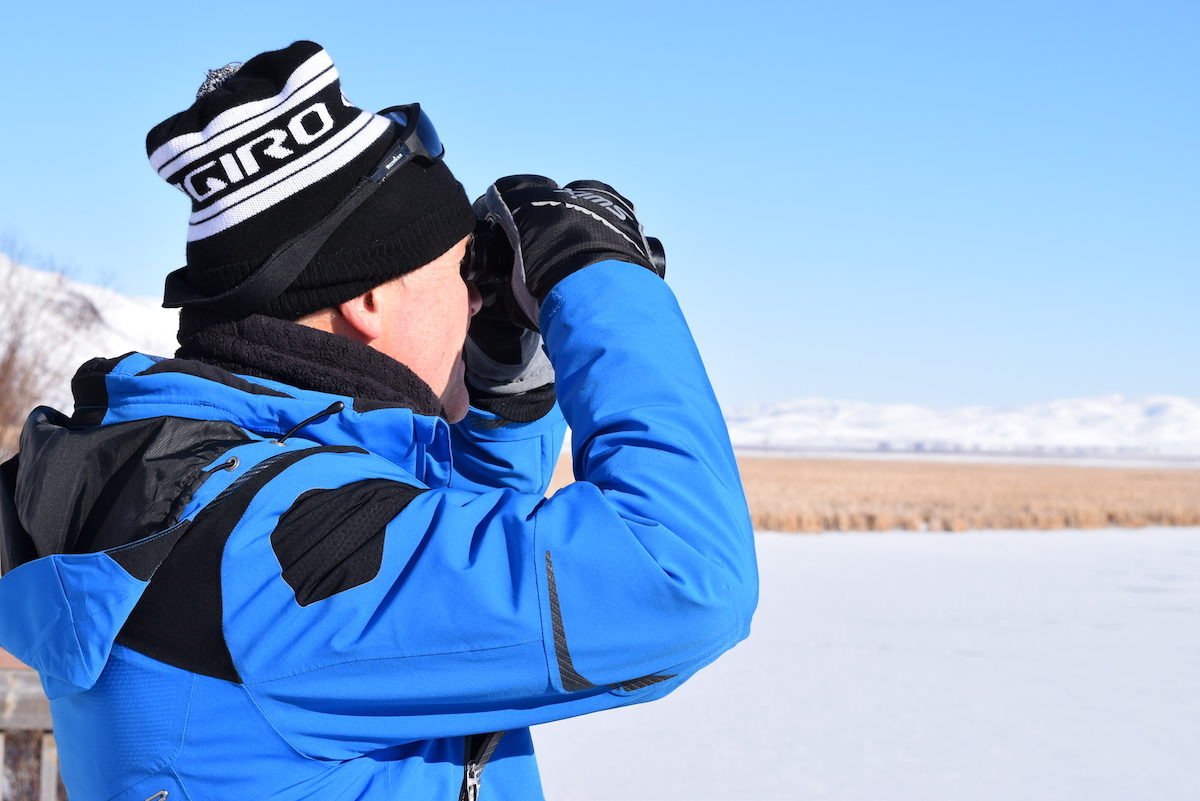
JHWF Board Member Bruce Pasfield tries to get an accurate count of Trumpeter Swans on the stretch of Flat Creek within the National Elk Refuge.
Temperatures never rose above zero during the 2016 Christmas Bird Count on December 17, but it was filled with the warmth of a wonderful tradition and the thrill of joyful interaction with the birds of winter.
According to Bert Raynes, the Jackson Hole Christmas Bird Count “got started 60 years ago and covered mostly good bird spots in and around the Murie Ranch near Moose. The counters were a plucky but small group, including Olaus and Adolph Murie and presumably their wives and some other locals.” The Audubon Society sponsors more than 2,500 annual international censuses of birds in North and South America at year-end. Susan Marsh organizes our local count and animates it with her nature-loving spirit.
The Jackson Hole Wildlife Foundation sent a team of two staff members (Kate Gersh and Jon Mobeck) and a board member (Bruce Pasfield) out into the field to join the count. Fueled by a good breakfast and conversation with fellow counters at Bubba’s, “Team Goldeneye” got on the board early with a Northern Shrike observation just below the National Museum of Wildlife Art. Driving along the highway north out of town, the team spotted several Common Ravens and viewed ten Trumpeter Swans beyond the dry rushes on a stretch of Flat Creek’s open water.
Moving farther north, “Team Goldeneye” stopped at the Fish Hatchery Pond to record waterfowl amid the fog from the frigid water. Here, the first six of 17 Barrow’s Goldeneyes introduced themselves along with 10 Mallards and a pair of Common Mergansers. While binoculars were set down for a moment to allow fingers to thaw, a Bald Eagle flew high above the pond eastward toward the Sleeping Indian, the first of three Bald Eagle observations. Let us not forget to mention the five Buffleheads we saw at the pond before piling back into the car. A curiously wandering crew, “Team Goldeneye” zipped past the Gros Ventre Junction for a short distance before circling back. While cruising just outside of its territory, Pasfield spotted some wings flapping in the sagebrush. Just as the one bird was definitely recorded as a Greater Sage Grouse, a flock of another 24 descended onto the flats to hide in the sage nearby. A beautiful sight!
The Jackson Hole Christmas Bird Count is a terrific holiday tradition, punctuated by a passionate cast of friendly characters who love to follow birds around the valley. The Jackson Hole Wildlife Foundation is grateful for each of them, and honored to have shared in the experience with many members of the Nature Mapping Jackson Hole family.
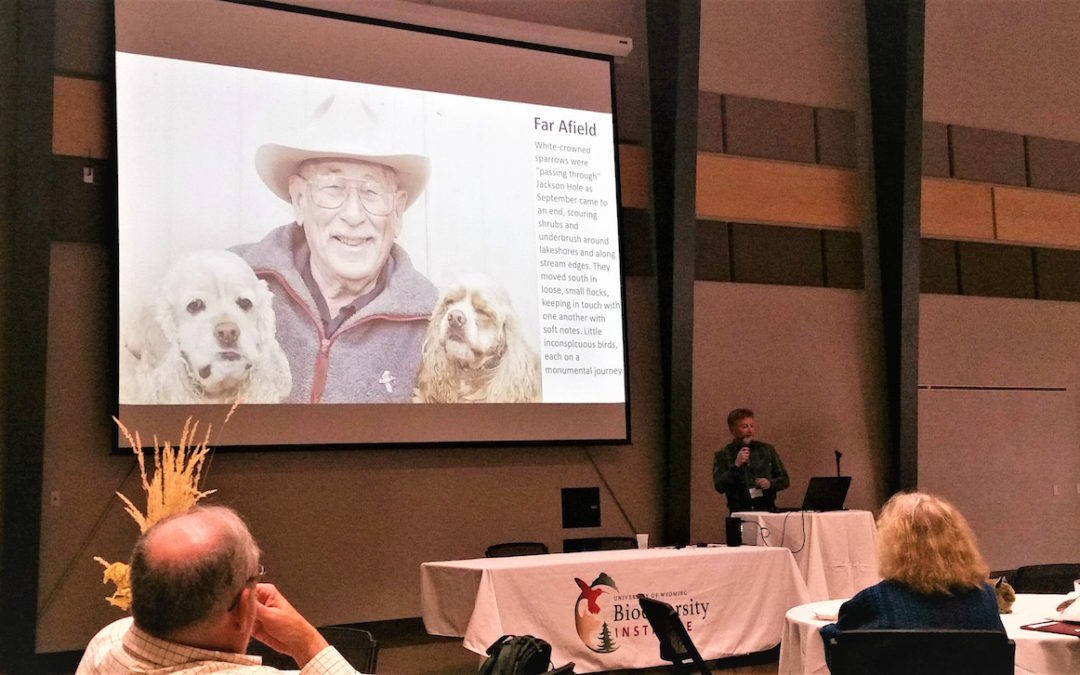
by jhwildlife | Dec 16, 2016 | Blog, Nature Mapping Jackson Hole
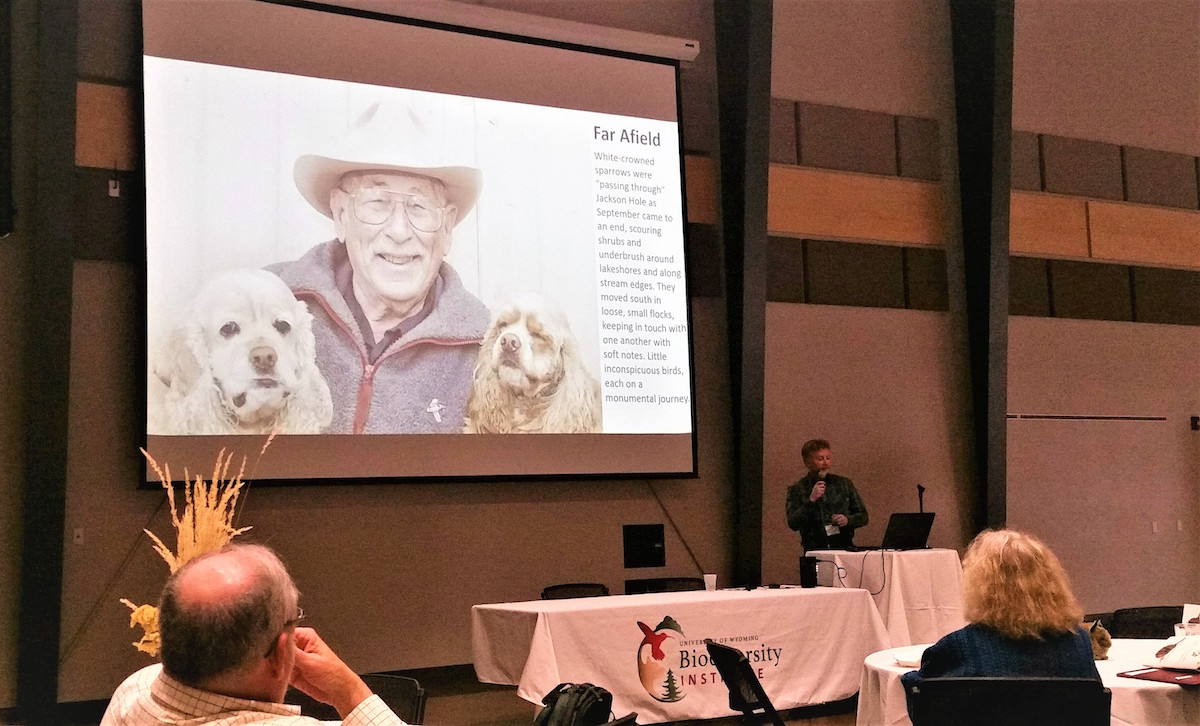
JHWF ED Jon Mobeck presents on the artistry of citizen science and the conservation legacy informing Nature Mapping Jackson Hole.
Earlier this month the University of Wyoming Biodiversity Institute hosted the first ever Wyoming Citizen Science Conference in Lander. Several representatives from the Jackson Hole Wildlife Foundation (JHWF) and Nature Mapping Jackson Hole (NMJH) attended the conference with the aim of learning from other citizen science practitioners across the state and of sharing what we have learned from the past eight years of running our program. The conference proved to be very valuable.
The variety of citizen science programs represented was immense and indicative of the breadth and depth available in Wyoming. For example, modeled on NMJH, Laramie sponsors both a winter and summer “Moose Day” with up to 38 transects and over 80 volunteers. Rocky Mountain Amphibian Project conducted a survey of chytrid fungus in frogs and toads throughout the state, including Teton County. A PhD student studied how geo-tagged imagery can enhance surveys by providing follow-up ID, unbiased assessments, and long-term documentation of plants and animals. Museums around the country are recruiting citizen scientists to review historical specimens, including label information on University of Wyoming herbarium sheets. Road Scholar (formerly Elderhostel) volunteers are chronicling archaeological sites in the Wind River Mountains. Associated with the North American Butterfly Association, twenty citizen scientists have tracked approximately 28 species of butterflies in a count circle in Lander for a decade. These are only a few of the amazing projects presented.
The core focus of the conference was on the problems and solutions that citizen science program managers and volunteers face. Several speakers talked about the difficulty of designing data sheets that capture essential information while also being user–friendly. Project directors need to enter and analyze data relatively quickly to keep citizen scientists engaged: volunteers are rewarded by seeing results of their work. Social occasions help build a concerned community. While ensuring quality remains challenging, with sufficient training citizen scientists produce solid scientific data. For instance, the Rocky Mountain Amphibian Project compared the quality of data collected by volunteers vs. bio-techs with very similar results. In short, presenters concluded, “Citizen scientists rock!” And we have a lot to learn from each other.
Our role in the conference:
On the whole, 65 conference participants came from across Wyoming, and even Idaho and Vermont too – all from a mix of individual citizen scientists, nonprofit organizations, primary and higher educational institutions and federal agencies.
JHWF was a silver-level sponsor for the Wyoming Citizen Science Conference, and our Associate Director Kate Gersh served on the program planning committee, which helped select presenters and set the agenda. Over the course of nearly two full days, here are a few programs that were presented by JHWF board, staff, and partners:
- “Lessons Learned: Eight Years of a Citizen Science Program in Jackson Hole” – Aly Courtemanch
- “Values Driving Conservation: Citizen Science as Interactive Art” – Jon Mobeck
- “Fundraising for Citizen Science: Experiences and Advice” – Kate Gersh, Anya Tyson, Wendy Estes-Zumpf, Frances Clark (in absence)
- Poster Presentation: Nature Mapping Jackson Hole: Mapping Community Solutions ̶ Kate Gersh
- Poster Presentation: Monitoring Wildlife Crossings on South Highway 89 ̶ Paul Hood
- “Bringing Citizen Science into the Backcountry: Emerging Best Practices to Engage Outdoor Education Organizations” – Anya Tyson
- Screening of Far Afield: A Conservation Love Story
Importantly, one of NMJH’s lead volunteers Tim Griffith attended the conference and contributed much to the conversation. Based on the latter and the abovementioned, we believe we successfully expanded awareness of Nature Mapping Jackson Hole statewide and regionally, thereby opening opportunities for greater community connections. This was a proud experience for us and we feel honored to have represented on behalf of everyone who has been involved with NMJH.
Next steps for Citizen Science
What comes next? Well, based on survey responses, conference participants have expressed a desire for open communication and collaboration between citizen science groups, as well as, one central location to list project information. The Biodiversity Institute is excited to share that they have begun the process of planning a website to act as a citizen science clearing house. It will provide a forum for discussion around citizen science projects in our region and to glean tips and ideas for best practice. It will also help to incorporate our projects into the classroom. In addition, the idea of a dedicated newsletter for citizen science groups in Wyoming is under discussion.
The hope is that this conference will take place again next year, giving us the opportunity to follow-up on tactics and ideas that were shared. We have much to learn still about volunteer recruitment and retention, fundraising, risk management, data collection and submission, data sharing and dissemination, evaluation and the list goes on. JHWF will be sure to keep you updated on new developments as they come about. Stay tuned as we continue to explore the potential of all that Nature Mapping Jackson Hole has to offer!
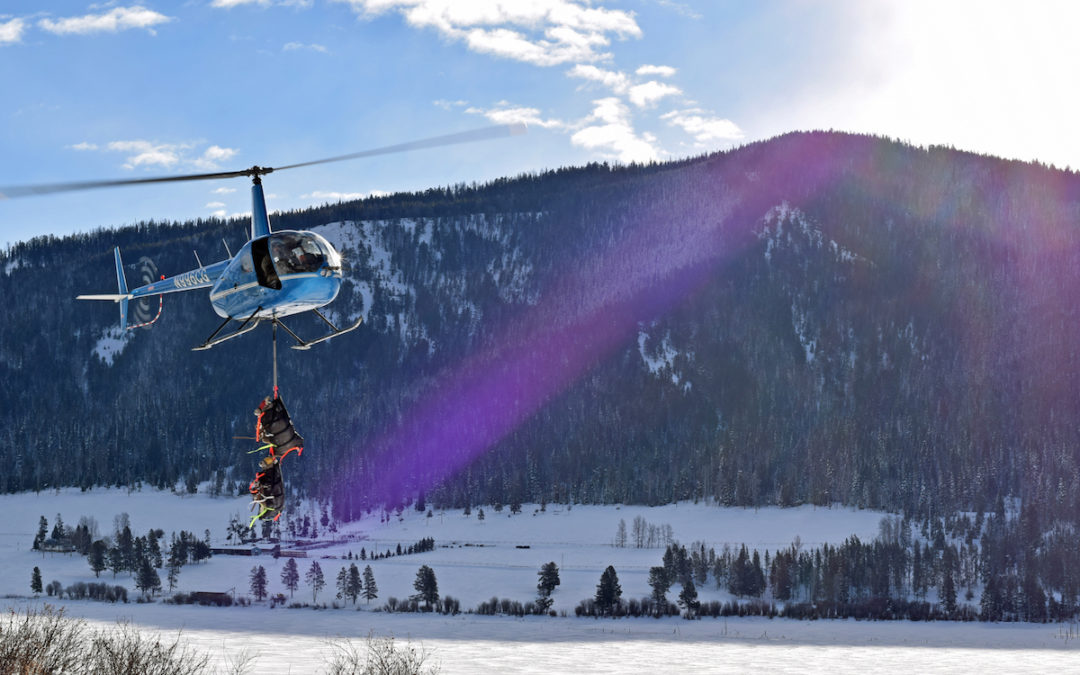
by jhwildlife | Dec 14, 2016 | Blog, Nature Mapping Jackson Hole
One of the perks of working for the Jackson Hole Wildlife Foundation is that occasionally you get invited by local scientists to do really, really cool stuff! Case in point, this past weekend staff traveled into the Gros Ventre Range with a crew of researchers to briefly capture, study and release bighorn sheep. Witnessing a small helicopter carrying blindfolded, restrained sheep at one or two at a time is very cool! This might sound alarming to some, that sheep would be transported from location to location via helicopter, but be assured that the animals are caught in the shortest possible time, with the least amount of stress. Furthermore, the purpose for this “trip of a lifetime” is to conduct science that will ensure the long-term survival of this iconic species of the American West.

The helicopter brings in two bighorn sheep for a gentle landing.
The Wyoming Game and Fish Department (WGFD) is continuing its multi-year research project on bighorn sheep in the Jackson Region. On December 10 and 11, 2016, 10 female bighorn sheep (previously fitted with radio collars) were captured for disease testing in an effort to learn more about their survival and migration patterns. Samples were collected to test for respiratory pathogens that can cause pneumonia. In addition, researchers from Dr. Kevin Monteith’s lab at Wyoming Cooperative Fish and Wildlife Research Unit at the University of Wyoming performed an ultrasound on each animal to measure body fat. This is a three-year study evaluating how body condition is related to pneumonia outbreaks.
The Jackson herd, which numbered 500 animals in the 1990s, has experienced two significant die-offs in recent years. In 2001, it was estimated that as many as 50% was lost due to a pneumonia outbreak and another estimated 30% lost again in 2011. Today it is estimated that the Jackson herd has climbed back to around 425 animals currently.
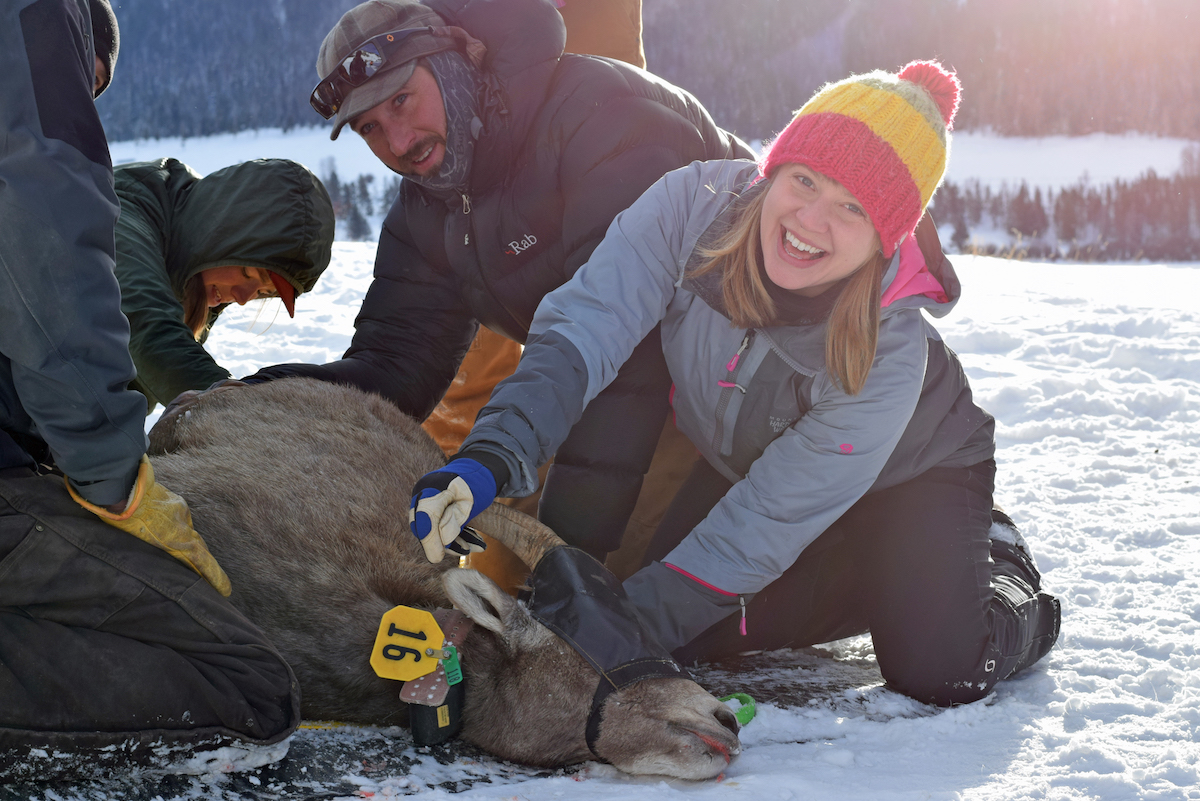
Kate Gersh and Greater Yellowstone Coalition wildlife program coordinator Chris Colligan assist the research team.
By monitoring individual female bighorn sheep (ewes) through time, researchers are assessing nutritional condition, pneumonia infection, and linking those data to reproductive performance, survival, and nutritional condition in subsequent seasons. At a minimum, they hope to begin to shed light on the complex interactions in the population dynamics of bighorn sheep and help identify possible management alternatives to reduce probability of pneumonia die-offs. For this specific research project, approximately 20 ewes have been collared. During the first three years of this project, biologists are expecting to recapture these same individual sheep each spring and fall to perform the same round of tests and evaluations. The team will go out again in March 2017, and attempt to catch more of their collared ewes to ascertain pregnancy and other health conditions.
JHWF staff is grateful to have been included in this project over the weekend and we thank the WGFD and Wyoming Cooperative Fish and Wildlife Research Unit for allowing us to see first-hand the efforts involved in conducting field research on bighorn sheep. We also thank all those involved for continuing to support wild sheep conservation efforts — you are doing excellent work!
View an image gallery of the work here.
References:
Bighorn Sheep Surveillance. (2016, March). Wyoming Game and Fish Department: Jackson Region Monthly Newsletter, 1. Retrieved December 13, 2016, from https://wgfd.wyo.gov/WGFD/media/content/PDF/Regional Offices/Jackson/2016_Mar_Jackson.pdf
Interview with Aly Courtemanch, Wildlife Biologist with Wyoming Game and Fish Department [Telephone interview]. (2016, December 13).
Koshmrl, M. (2015, March 25). Bighorns get their checkup. Jackson Hole News & Guide.
Nutritional dynamics and interactions with disease in bighorn sheep. (n.d.). Retrieved December 13, 2016, from http://wyocoopunit.org/projects/nutritional-dynamics-and-interactions-with-disease-in-bighorn-sheep.
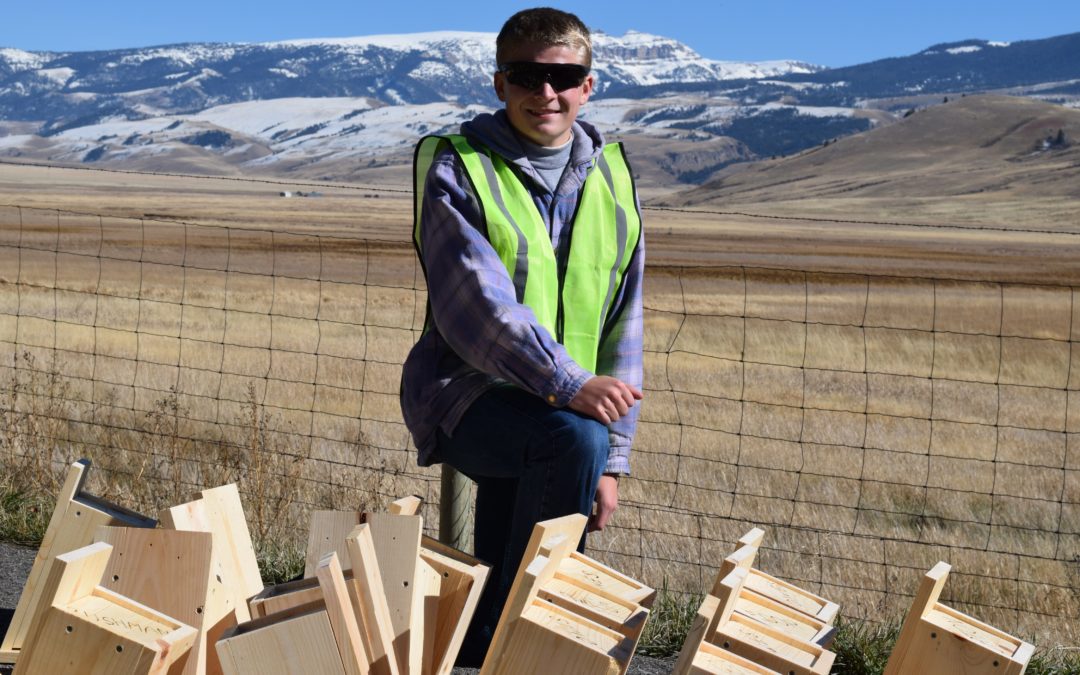
by jhwildlife | Oct 26, 2016 | Blog, Nature Mapping Jackson Hole
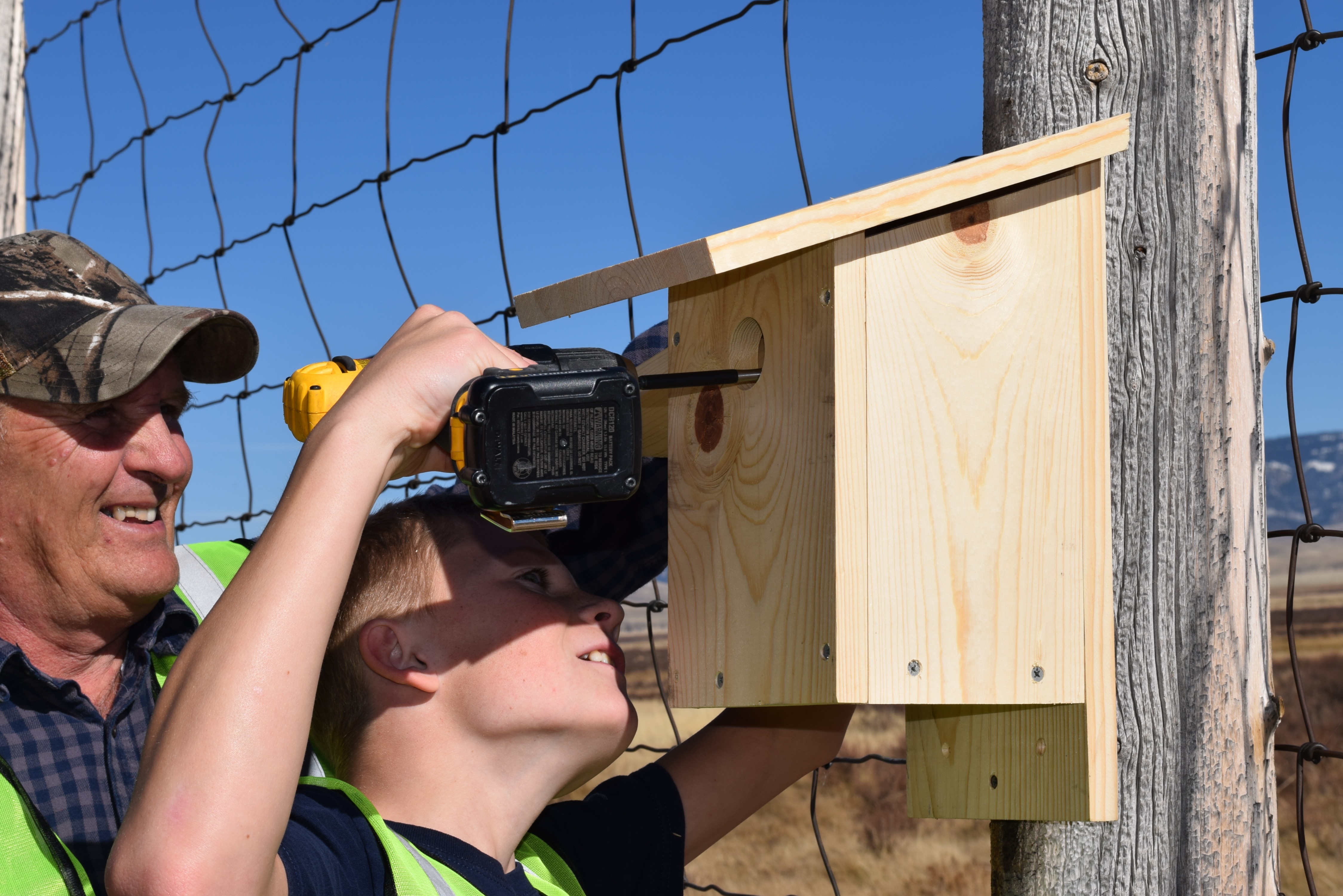
Eagle Scout is the highest achievement or rank attainable in the Boy Scouting program of the Boy Scouts of America. The requirements necessary to achieve this rank take years to fulfill, and must include completion of an extensive service project that the Scout plans, organizes, leads, and manages. Luckily for the Jackson Hole Wildlife Foundation, prospective Eagle Scout Maclain Smith from Utah, made us the beneficiary of his service project. This past Friday afternoon, Maclain came up to Jackson to install 52 Mountain bluebird nestboxes that he and fellow Scouts constructed by hand.
With lots of laughs and great spirit, Maclain and nine of his family members spent a sunny autumn afternoon installing new pinewood nestboxes on half of our Mountain bluebird trail that runs along the western boundary of the National Elk Refuge. Our old nestboxes (that served their purpose for 13 years!) were taken to Teton Recycling Center where they will be repurposed into wood mulch and used for gardening and landscaping purposes. After 13 years, we felt it time to retire the old nestboxes as they had seen many repairs over the years, but their deteriorating condition was starting to present challenges in terms of predator control and protecting nests from bad weather conditions.
Not only are we fortunate to have the help of Maclain, but we currently have two more prospective Eagle Scouts producing a total of 72 additional nestboxes that will be installed this coming spring. Of these 72 — the other half of our trail will receive 52 new nestboxes, we are looking into placing additional nestboxes elsewhere on the National Elk Refuge, and keep a few in storage. Thank goodness for Scouts!
Click here to see a photo gallery documenting Maclain installing new Mountain bluebird nestboxes with the help of his family and JHWF staff.
Click here to read an account of the project published by the National Elk Refuge.
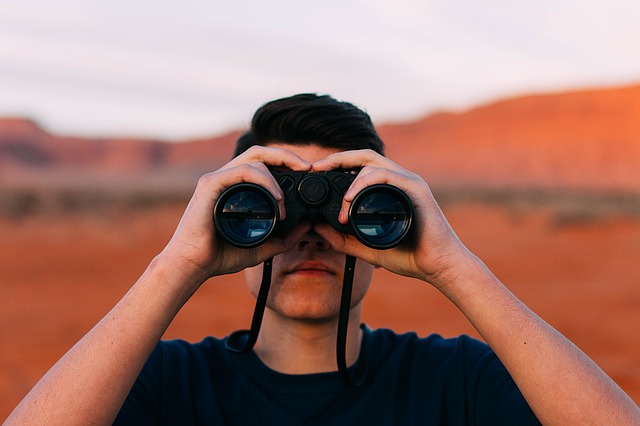
by jhwildlife | Oct 17, 2016 | Blog, Nature Mapping Jackson Hole
Registration is now open for the first ever Wyoming Citizen Science Conference! Hosted by the UW Biodiversity Institute, the conference will involve keynote and breakout sessions that guide program managers and citizen science participants (teachers, Scout leaders, community activists, etc.) to weigh in on what works well (and what doesn’t) in terms of having a successful, impactful citizen science program. The conference will be held in Lander, Wyoming, on December 1-2, 2016, and with an optional day on Saturday, December 3 to attend focused workshops.
We hope you can join us. The Jackson Hole Wildlife Foundation will be in attendance to represent Nature Mapping Jackson Hole – delivering two oral presentations and presenting two project posters in addition to, screening the film Far Afield. We’ll mainly be talking about lessons learned from the past eight years of Nature Mapping Jackson Hole, sharing our experiences and intending to learn much from others in attendance that will come from across the state. The organizers of this inaugural event hope to have a strong representation from active citizen scientists, not just those serving in professional capacities. Register today and come learn, share and be inspired!
Details on the conference agenda can be found here.
